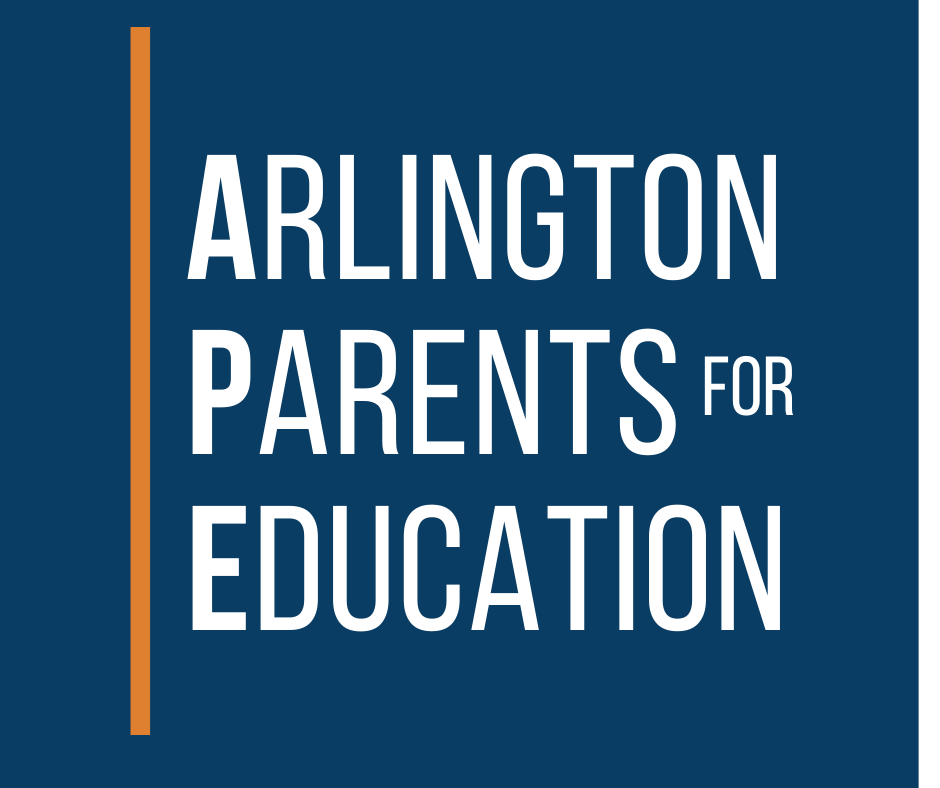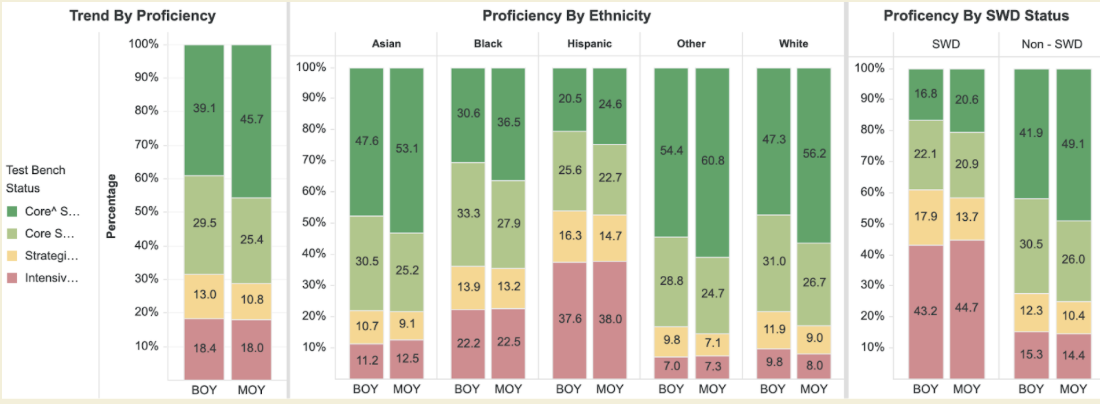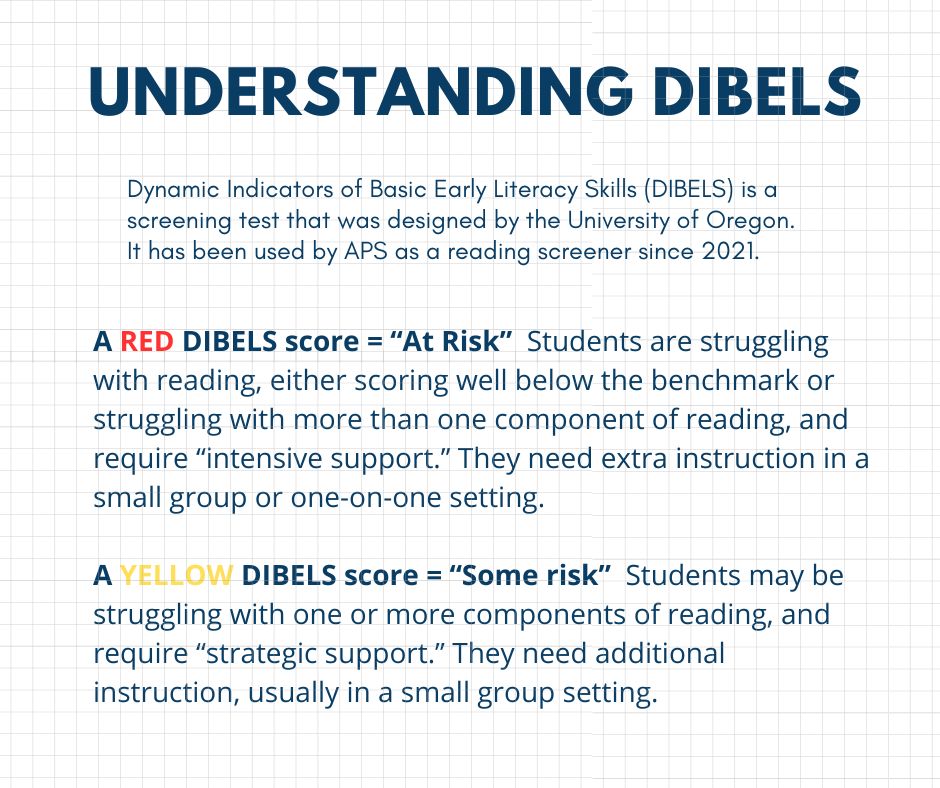March 12, 2024 Newsletter
In This Edition:
1. APS Faces a Budget Shortfall Next Year & Beyond
2. Mid-Year DIBELS Results Show Concerning Trends
3. APE Report: APS' Intensified Classes vs. 'Algebra For None' & VMPI
4. Parent's Corner: Arlington Students Deserve Phone-Free Schools
5. APS Compresses Budget Work Sessions Into Just One Day
6. The Academic Consequences of Chronic Absenteeism
7. March 7th School Board Meeting Recap
8. Happening Soon
APS Faces a Budget Shortfall Next Year & Beyond
Last week, Superintendent Duràn released his budget request for next school year. His request of $825 million is a modest 1.5% increase over this year’s adopted budget, but there is presently a $29.5 million shortfall, even after accounting for more than $18 million in cuts at Syphax and nearly $3 million in cuts to schools. Worse, APS projects even larger shortfalls in the three years after the 2024-2025 school year, of $60, $70, and $78 million (see page 73 of the budget request), which School Board member Kadera addressed in her remarks.
The budget presentation included several scenarios in which the $29.5 million shortfall for the coming school year decreases, but is not entirely filled. At present, the County Board has advertised a possible property tax rate increase of 2.5% and Virginia’s General Assembly is finalizing a biennial budget that increases funding for public education. However, APS’ budget does not balance under any scenario presented. Even if the County Board increases property taxes and the General Assembly provides more school funding there will still be a shortfall of at least $3.4 million and possibly higher. In past years, APS has put forward possible tiered reductions to explain how they will balance the budget if revenues did not materialize. (See Tier 1, 2 & 3 reductions in the 2020 budget for example). However, this year APS has not provided any options for how it will cover projected shortfalls next year, which range from $3.4 to $29.5 million.
Why It Matters: The budget that APS released is fundamentally incomplete and lacks transparency. The community does not know how APS intends to make up the shortfall for next year. Will it be an increase in class sizes or freezing teachers’ cola or step, as happened in both 2020 and 2021? Is APS considering efficiencies like a gradual shift to chromebooks as the Teachers’ Council on Instruction has previously proposed? We do not know because APS has not provided that information in this year’s request. Likewise, there is no evidence of how APS intends to fill even deeper shortfalls in the next few years, despite APS’ Budget Advisory Council previously calling for contingency plans to address APS’ structural deficits.
Over the last few years, we have repeatedly advocated for investment of historic one-time funds at a time of an historic level of need. We have advocated for an increase in both one-time funding and in the County revenue share for APS (see 2022 and 2023letters to the County Board), as well as more funding from the General Assembly. At the same time, we have warned that APS will face structural deficits in future years, urging a freeze to Syphax hiring and emphasizing the need to find more efficiencies and better oversight. Now the historic one-time funds are gone, yet significant needs remain - midyear academic data indicate widening achievement gaps and teachers are frustrated by class sizes and compensation.
For more background on why it matters, we recommend watching public comments from the March 7th School Board meeting.
Read our prior advocacy around these issues (see our Advocacy in Action, APE reports, Think Tanks, and past newsletters) and engage with our County Board, School Boardand the General Assembly.
2023-2024 Mid-Year (MOY) DIBELS Results
Show Concerning Trends
APS recently released middle of the year (MOY) DIBELS reading assessment results for K-5. Dr. Durán shared in an email to parents that, “Across the school division, mid-year DIBELS results indicate that 71.1% of our K-5 students are on track to demonstrate proficiency in grade-level literacy skills by the end of the school year; this represents a 1.3% increase from last year’s mid-year data.” However, the results reveal some concerning trends this school year.
We Looked at the Data. Here’s What We Found:
The number of Asian, Black and Hispanic students in K-5 requiring an intensive (RED) level of support increased.
The number of English Learners (EL) and Students with Disabilities (SWDs) requiring an intensive (RED) level of support increased.
In addition, the number of students requiring intensive (RED) support in grades 3-5 has increased since the beginning of the school year. This is particularly concerning because by 4th grade students should be “reading to learn” rather than learning to read.
Overall, 35.7% of Black students, 52.7% of Hispanic students, 58.4% of SWDs, 50.9% of ELLs, 17% of White students, and 14.4% of “Other” students are below grade level and require intensive (RED) or strategic (YELLOW) levels of support.
ALL STUDENTS K-5
STUDENTS IN THIRD GRADE
Why It Matters:
APS uses beginning of year DIBELS test results to determine who needs additional reading support. This additional support usually entails placing students in reading groups or assigning more time on the LEXIA reading mobile application. However, these negative trends call into question whether students with the greatest reading needs are being supported appropriately or adequately. Why is the number of minority students and students with disabilities who need support growing?
If you are concerned about your student’s progress in reading, we would like to hear from you. Please email us.
To see the full DIBELS results for your school, see the APS DIBELS dashboard.
On March 5th, 84% of San Francisco voters supported a referendum for San Francisco Unified School District (SFUSD) to bring back Algebra for 8th graders, after data showed that SFUSD’s controversial policy of restricting Algebra to 9th grade was inequitable.
Why It Matters: In 2021, the Virginia Math Pathways Initiative (VMPI) proposed a similar policy for all of Virginia based upon SFUSD’s preliminary (however, misrepresented) data. This proposal was met with blowback from the Virginia public similar to that which erupted California. In contrast, APS' successful rollout of intensified Middle School classes is demonstrating how equity is actually furthered – by providing academic opportunities for all, not by removing them.
Read more in our APE Report.
Parent's Corner:
Arlington Students Deserve Phone-Free Schools
(Editor's Note: From time to time we will offer op-eds, which are the unedited perspectives of an APS parent or teacher on a topic of interest or concern to APS.)
The policy implementation for student personal phones at school varies based on school administration and classroom teacher. APS' current strategy is to teach students self-regulation because these devices have become a normal part of life.
That being said, the number of districts with an Away for the Day policy continues to increase and is currently around 77%, with Fairfax county being the latest to implement such a policy. Smartphone addiction is on the rise, while test scores and mental health are falling. The research is clear: Smartphones undermine attention, learning, relationships, and belonging.
Students need a more comprehensive policy implementation in order to regain the amount of focus required to complete their school work and learn the social skills required to engage their peers face-to-face. Educators Say Cellphone Bans Can Ease Students’ Stress and Anxiety.
Most APS middle schools have a policy which stipulates that phones are not to be seen in the classroom, and most APS high schools have the same policy with the addition that they may be taken out at a teacher's directive for educational purposes. In reality, students are distracted checking their phones during class time for a median usage of 43 minutes during school hours, and policies are loosely enforced, according to a Common Sense Media Survey. The status quo requires an amount of self-regulation that it is not fair to expect from young students.
We must consider how the following new solutions would make implementation effective and easy.
A set of cubbies at the door of each classroom where the phone is left, only to be retrieved at the end of class.
A set of pouches which travel with students and are locked at the beginning of the day and unlocked at the end of the day by the administration.
A set of lockers where phones remain for the duration of the school day and are retrieved at the end of the day.
Parents need to reach their students while at school. This can happen via the front office or via a new app on school-issued devices. Given that many students are addicted, implementation of Away for the Day will likely present challenges for teachers & administrators. We must count the cost, knowing that our students are worth fighting for, and knowing that many schools have successfully implemented this policy before us.
APS Compresses Budget Work Sessions Into Just One Day
Over the coming weeks, we will pore through the budget book and share our takes as we have in past years. However, one significant change impacting budget consideration will likely hamper transparent and deliberation consideration of the $825 million request. Compared to last year, the budget development calendar is shorter, has fewer work sessions, and, most concerning, four work sessions have been compressed to one day. Last year, APS had 6 work sessions, spanning several months. Work Session #1 was held on February 23rd and Work Session #6 was held 10 weeks later on May 2nd. In contrast, this year’s budget development calendar provides for only four budget work sessions to be held on a single day, March 19th.
Why It Matters: Adopting the budget is the most significant School Board responsibility. Public deliberation spread out over the course of several months gives school board members and the public adequate time to digest the details, ask questions of staff, and follow-up as appropriate. APS has moved to this condensed model for other work and monitoring sessions and we recognize that this practice has scheduling advantages. It does not seem appropriate, however, to extend this practice to the 12-week budget development calendar. Holding all budget work sessions on a single day, and a mere 19 days after the release of the Superintendent’s request, instead subjects board members and the public to a fire-hose of budget data and detail. It is the antithesis of thoughtful and transparent deliberation of an $825 million request that impacts more than 28,000 students and 5,245 full-time equivalent employees.
The Academic Consequences of Chronic Absenteeism
APS is suffering through post-COVID chronic absenteeism, like schools throughout Virginia and the US.
Why It Matters: Dr. Durán’s email on March 6 noted important information on how chronic absenteeism (defined as 10% or more of the school year, or about 18 days) affects APS students academically. APS also included such information in its Friday Five email on March 8th:
APS student performance data from the 2022-23 school year reveals that APS students who were chronically absent had, on average:
· 20% lower pass rate on the Reading SOL
· 26% lower pass rate on the Math SOL
· 94% did not complete Algebra 1 by 8th grade
· 1.19 pts lower GPA in high school
· 15 times less likely to graduate on time
Our Take: Every day in school matters, and we’re grateful that Dr. Durán is attempting to quantify how much it matters for APS students academically.
March 7th School Board Meeting Recap
There were no board announcements, superintendent announcements or public comment due to Dr. Durán's budget presentation, which highlighted three main priorities:
Student Well-Being and Academic Progress
$2.7 million (additional 20.75 FTEs): due to ‘enrollment changes’ (Editor’s note: the enrollment at APS is roughly identical to 2019 levels, yet this represents a significant increase over FTEs in 2019-2020 school year).
$3.7M: Maintain supports for ‘special populations’, e.g. English learners
Adding Lightspeed: would alert staff so a threat assessment can be done based on what a student is writing on an APS device.
$2.8M: Continue existing instructional resources and supports.
Recruit, Retain and Invest in Staff: Proposed: 3.3% average staff compensation increase ($17.1M): $11.2M Step adjustment & $5.9M 1% COLA
Operational Excellence
$4.1M total investment, but need additional funding to address ‘Unmet Needs’
Need $6.4M from County Board
School Board members discussed the presentation, with Ms. Kadera commenting: “Over the years, I have heard people bristle at the idea that APS has a structural deficit. In fact, we do. Our share of revenues…do not cover our ongoing expenses. Our budget advisory board has expressed this concern multiple times," then cited other local school systems (FCPS and LCPS) with structural deficits and said relying on reserve funds to plug ongoing deficits is not fiscally responsible. Ms. Turner then compared the $2.7M in Central admin staff cuts to the $2.1M in school-based staff cuts, noting that the same number of positions were being cut in Syphax as were being eliminated in schools. Given that school-based cuts directly impact students, she challenged Dr. Durán to ‘take a hard look’ at central admin costs and find additional ways to cut instead of cutting school-based staff.
Read the full recap here.
Happening Soon!
Wednesday, March 13 8 PM, APE virtual School Board Candidate Forum. Register here.
Thursday, March 14, 7 PM - 9 PM, Public Hearing on Superintendent’s Proposed FY 2025 Budget. Sign up to speak. Syphax. Watch live.
Thursday, March 14, 7:30 PM - 9 PM, Arlington SEPTA March Meeting with Best Buddies of DC and Virginia. Syphax, Room 454 or Zoom. Register here.
Friday, March 15, 8 AM, Audit Committee Meeting. Syphax, Suite 260.
Tuesday, March 19, 9 AM - 5 PM, Budget Work Session. Syphax. Watch live.
Wednesday, March 20, 8 AM, Policy Subcommittee Meeting. Syphax, Suite 260.
Thursday, March 21, 7 PM, School Board Meeting. Sign up to speak. Syphax. Watch live.
Friday, March 22, 3 PM - 5 PM, Joint School Board/County Board Budget Work Session at Bozman Government Center, 2100 Clarendon Blvd., Ste. #307. Watch live.
Monday, April 1, 7-9 pm, Office Hours with School Board Member Mary Kadera. Virtual. Sign up.
Don't forget! You can subscribe to APS School Calendars here.




